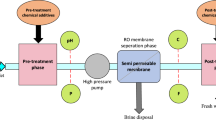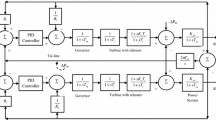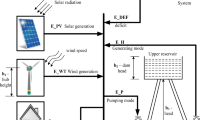Abstract
In this study, the pressure-retarded osmosis (PRO) process is optimized using Harris hawks optimization (HHO)-based maximum power point tracking (MPPT) technology. To make the practical implementation of salinity-gradient-based energy harvesting using PRO feasible, MPPT is envisaged to play a substantial role. Therefore, this study focuses on the development of a novel MPPT controller using swarm intelligence. The HHO algorithm is the latest approach that mimics the unique chasing strategy of Harris hawks in nature. To test the cost effectiveness of the proposed method, two case studies with various operational scenarios are presented. Compared with the performance of selected well-known and recent approaches, such as perturb & observe, incremental mass resistance, and whale optimization algorithm techniques, that of the proposed metaheuristic-based MPPT technique is found to be highly competitive. Results also show that the proposed algorithm can overcome other methods’ limitations, such as low tracking efficiency; low robustness when encountered in various operational conditions, including temperature and salinity; and steady-state oscillations. Furthermore, the proposed MPPT strategy is suitable for use in other fields of renewable energy harvesting.
Similar content being viewed by others
References
Loeb S, Norman R S. Osmotic power plants. Science, 1975, 189: 654–655
Loeb S. Production of energy from concentrated brines by pressure-retarded osmosis. J Membrane Sci, 1976, 1: 49–63
Pattle R E. Production of electric power by mixing fresh and salt water in the hydroelectric pile. Nature, 1954, 174: 660
Logan B E, Elimelech M. Membrane-based processes for sustainable power generation using water. Nature, 2012, 488: 313–319
He W, Wang Y, Shaheed M H. Maximum power point tracking (MPPT) of a scale-up pressure retarded osmosis (PRO) osmotic power plant. Appl Energy, 2015, 158: 584–596
He W, Luo X, Kiselychnyk O, et al. Maximum power point tracking (MPPT) control of pressure retarded osmosis (PRO) salinity power plant: development and comparison of different techniques. Desalination, 2016, 389: 187–196
Chen Y, Vepa R, Shaheed M H. Enhanced and speedy energy extraction from a scaled-up pressure retarded osmosis process with a whale optimization based maximum power point tracking. Energy, 2018, 153: 618–627
Maisonneuve J, Chintalacheruvu S. Increasing osmotic power and energy with maximum power point tracking. Appl Energy, 2019, 238: 683–695
Long R, Lai X, Liu Z, et al. Pressure retarded osmosis: operating in a compromise between power density and energy efficiency. Energy, 2019, 172: 592–598
Wasynezuk O. Dynamic behavior of a class of photovoltaic power systems. IEEE Trans Power Apparatus Syst, 1983, PAS-102: 3031–3037
Hussein K H, Muta I, Hoshino T, et al. Maximum photovoltaic power tracking: an algorithm for rapidly changing atmospheric conditions. IEE Proc Gener Transm Distrib, 1995, 142: 59–64
Mousa H H H, Youssef A R, Mohamed E E M. Variable step size P&O MPPT algorithm for optimal power extraction of multi-phase PMSG based wind generation system. Int J Electrical Power Energy Syst, 2019, 108: 218–231
Kumar R, Khandelwal S, Upadhyay P, et al. Global maximum power point tracking using variable sampling time and p-v curve region shifting technique along with incremental conductance for partially shaded photovoltaic systems. Sol Energy, 2019, 189: 151–178
Dufo-López R, Bernal-Agustín J L, Contreras J. Optimization of control strategies for stand-alone renewable energy systems with hydrogen storage. Renew Energy, 2007, 32: 1102–1126
Chen Y, Alanezi A A, Zhou J, et al. Optimization of module pressure retarded osmosis membrane for maximum energy extraction. J Water Process Eng, 2019, 32: 100935
Liu Y, Zhang Y, Li P, et al. Uncalibrated downward-looking UAV visual compass based on clustered point features. Sci China Inf Sci, 2019, 62: 199202
Chen D, Li W, Liu X, et al. Effects of measurement noise on flocking dynamics of cucker-smale systems. IEEE Trans Circ Syst II, 2020, 67: 2064–2068
Duan H B, Zhang D F, Fan Y M, et al. From wolf pack intelligence to UAV swarm cooperative decision-making (in Chinese). Sci Sin Inform, 2019, 49: 112–118
Guo Y Y, Xu B, Han W X, et al. Robust adaptive control of hypersonic flight vehicle with asymmetric AOA constraint. Sci China Inf Sci, 2020, 63: 212203
Zhang R, Xu B, Wei Q, et al. Harmonic disturbance observer-based sliding mode control of MEMS gyroscopes. Sci China Inf Sci, 2022, 65: 139201
Chen D, Kang M, Yu W. Probabilistic causal inference for coordinated movement of pigeon flocks. EPL, 2020, 130: 28004
Yang B, Zhang X, Yu T, et al. Grouped grey wolf optimizer for maximum power point tracking of doubly-fed induction generator based wind turbine. Energy Convers Manage, 2017, 133: 427–443
Ann R A, Kalaivani L. A GOA-RNN controller for a stand-alone photovoltaic/wind energy hybrid-fed pumping system. Soft Comput, 2019, 23: 12255–12276
Heidari A A, Mirjalili S, Faris H, et al. Harris hawks optimization: algorithm and applications. Future Generation Comput Syst, 2019, 97: 849–872
Chen H, Jiao S, Wang M, et al. Parameters identification of photovoltaic cells and modules using diversification-enriched Harris hawks optimization with chaotic drifts. J Cleaner Production, 2020, 244: 118778
Houssein E H, Hosney M E, Oliva D, et al. A novel hybrid Harris hawks optimization and support vector machines for drug design and discovery. Comput Chem Eng, 2020, 133: 106656
Wolpert D H, Macready W G. No free lunch theorems for optimization. IEEE Trans Evol Computat, 1997, 1: 67–82
Wang L, Wang W, Wang Y Y, et al. Feasibility of reinforcement learning for UAV-based target searching in a simulated communication denied environment (in Chinese). Sci Sin Inform, 2020, 50: 375–395
Neggaz N, Houssein E H, Hussain K. An efficient Henry gas solubility optimization for feature selection. Expert Syst Appl, 2020, 152: 113364
Ridha H M, Heidari A A, Wang M, et al. Boosted mutation-based Harris hawks optimizer for parameters identification of single-diode solar cell models. Energy Convers Manage, 2020, 209: 112660
Avlonitis S A, Kouroumbas K, Vlachakis N. Energy consumption and membrane replacement cost for seawater RO desalination plants. Desalination, 2003, 157: 151–158
He W, Wang Y, Mujtaba I M, et al. An evaluation of membrane properties and process characteristics of a scaled-up pressure retarded osmosis (PRO) process. Desalination, 2016, 378: 1–13
Kim Y C, Elimelech M. Potential of osmotic power generation by pressure retarded osmosis using seawater as feed solution: analysis and experiments. J Membrane Sci, 2013, 429: 330–337
Yip N Y, Elimelech M. Thermodynamic and energy efficiency analysis of power generation from natural salinity gradients by pressure retarded osmosis. Environ Sci Technol, 2012, 46: 5230–5239
He W, Wang Y, Shaheed M H. Modelling of osmotic energy from natural salt gradients due to pressure retarded osmosis: effects of detrimental factors and flow schemes. J Membrane Sci, 2014, 471: 247–257
Straub A P, Lin S, Elimelech M. Module-scale analysis of pressure retarded osmosis: performance limitations and implications for full-scale operation. Environ Sci Technol, 2014, 48: 12435–12444
Lefebvre L, Whittle P, Lascaris E, et al. Feeding innovations and forebrain size in birds. Anim Behaviour, 1997, 53: 549–560
Bednarz J C. Cooperative hunting in Harris’ hawks (Parabuteo unicinctus). Science, 1988, 239: 1525–1527
Yang X-S. Nature-Inspired Metaheuristic Algorithms. Frome: Luniver Press, 2010
He W, Wang Y, Shaheed M H. Enhanced energy generation and membrane performance by two-stage pressure retarded osmosis (PRO). Desalination, 2015, 359: 186–199
Acknowledgements
This work was supported in part by National Natural Science Foundation of China (Grant Nos. 61933010, 61803305), Shaanxi Natural Science Foundation (Grant Nos. 2020JQ-223, 2019JZ-08, 2020JQ-213), and Aeronautical Science Foundation of China (Grant No. 201905053005).
Author information
Authors and Affiliations
Corresponding author
Rights and permissions
About this article
Cite this article
Chen, Y., Shi, Z., Xu, B. et al. Optimal design of a scaled-up PRO system using swarm intelligence approach. Sci. China Inf. Sci. 64, 222203 (2021). https://doi.org/10.1007/s11432-020-3110-x
Received:
Revised:
Accepted:
Published:
DOI: https://doi.org/10.1007/s11432-020-3110-x




